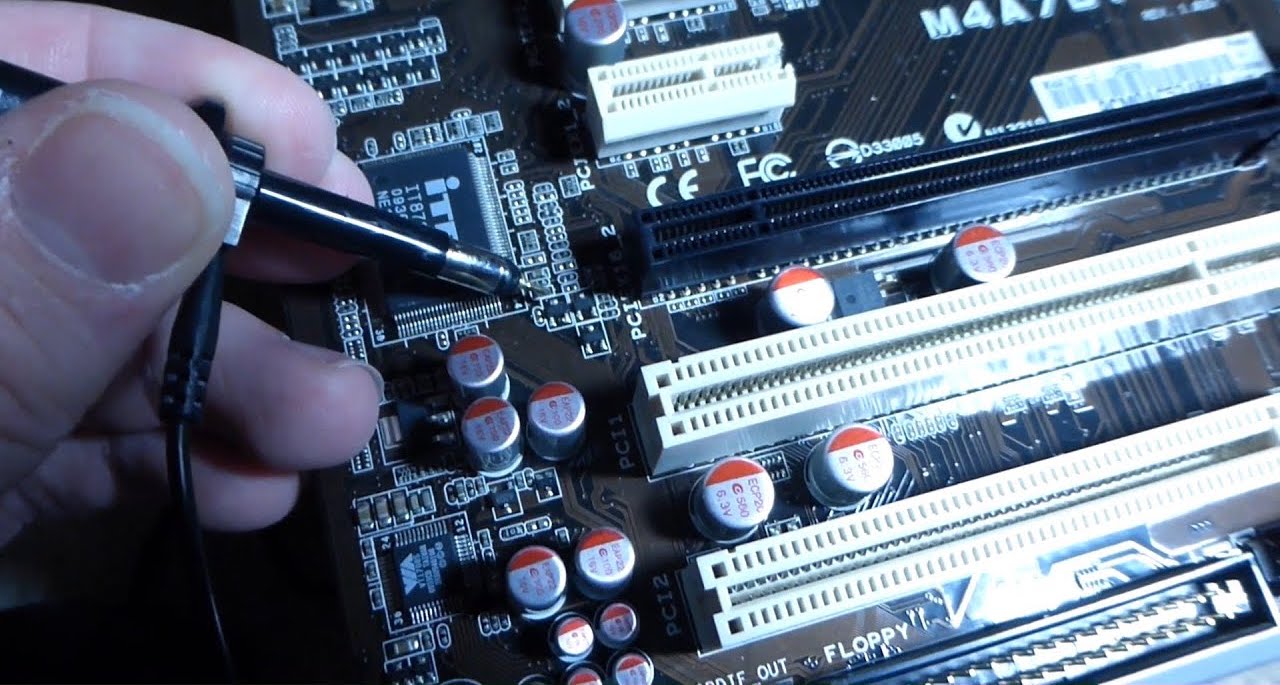Home>Home Security and Surveillance>When Was Intrusion Detection Introduced


Home Security and Surveillance
When Was Intrusion Detection Introduced
Modified: March 6, 2024
Discover the history of home security and surveillance with a closer look at the introduction of intrusion detection. Learn how this technology has evolved over time and its importance in safeguarding your property.
(Many of the links in this article redirect to a specific reviewed product. Your purchase of these products through affiliate links helps to generate commission for Storables.com, at no extra cost. Learn more)
Introduction
Welcome to the world of home security and surveillance!
In today’s rapidly evolving digital landscape, ensuring the safety and security of our homes has become a top priority. With advancements in technology, home security and surveillance systems have become more sophisticated and accessible than ever before. These systems provide homeowners with peace of mind, allowing them to monitor and protect their properties even when they are away.
Intrusion detection plays a pivotal role in home security and surveillance. It involves the constant monitoring of a property for any unauthorized access or suspicious activities. By detecting and alerting homeowners about potential threats, intrusion detection systems help to prevent burglaries, vandalism, and other criminal activities.
In this article, we will delve into the fascinating world of intrusion detection, exploring its history, development, and the challenges and possibilities that lie ahead. So, let’s take a journey through time and discover when intrusion detection was first introduced.
Key Takeaways:
- Intrusion detection has evolved from ancient security measures to sophisticated AI-powered systems, protecting homes from unauthorized access and cyber threats. It continues to adapt to new challenges for enhanced security.
- Future intrusion detection systems will utilize advanced AI, collaboration, and threat intelligence sharing to combat evolving threats such as APTs, insider threats, encrypted traffic, and IoT vulnerabilities.
Read more: What Is Wireless Intrusion Detection
Early Developments in Intrusion Detection
The concept of detecting intrusions and protecting properties traces back to ancient times. In ancient civilizations, humans employed various techniques to secure their homes, including locks, guards, and even the use of animals to serve as early detection systems.
However, the modern development of intrusion detection systems began to take shape during the mid-20th century. With the advent of electricity and telecommunications, new opportunities emerged to create more sophisticated security mechanisms.
In the 1950s, the first primitive intrusion detection systems started to emerge, primarily in commercial and military applications. These early systems predominantly used mechanical switches, magnetic contacts, and pressure mats to detect physical intrusions. When triggered, these sensors would activate an audible alarm or send a signal to a central monitoring station.
As technology advanced, so did intrusion detection systems. In the 1970s, the introduction of computer-based systems revolutionized the field. These systems were capable of monitoring electronic signals, such as motion sensors, break beam detectors, and glass breakage sensors.
The 1980s saw further advancements with the integration of software-based solutions. The development of computer networks and the internet allowed for remote monitoring and control of intrusion detection systems. This brought about a new era of convenience and accessibility.
During this time, security experts and researchers also began focusing on improving the accuracy and effectiveness of intrusion detection systems. They explored various algorithms, machine learning techniques, and statistical models to identify patterns and anomalies in the data collected by the sensors. These developments laid the foundation for the sophisticated intrusion detection systems we have today.
It is important to note that while the early developments in intrusion detection were primarily focused on commercial and military applications, they laid the groundwork for the advancements that would eventually make their way into residential security systems.
With the foundation set, the stage was now set for the birth of dedicated intrusion detection systems designed specifically for home security and surveillance.
Birth of Intrusion Detection Systems (IDS)
The birth of dedicated intrusion detection systems (IDS) marked a significant milestone in the evolution of home security and surveillance. IDS are specially designed to detect and prevent unauthorized access to computer networks, systems, and sensitive information. While initially developed for use in corporate environments, IDS technology quickly found its way into home security systems as well.
During the 1990s, as personal computers became more common in households, the need for protecting home networks from cyber threats became apparent. This led to the development of IDS systems that could monitor and analyze network traffic, looking for patterns and signatures of malicious activity.
Early IDS systems relied on rule-based detection methods. The system would compare network traffic against a predefined set of rules or signatures to identify potential threats. If a match was found, an alert would be triggered, and appropriate action could be taken.
While rule-based detection was effective against known threats, it struggled with detecting new and emerging attack patterns. This led to the development of anomaly-based detection techniques. Anomaly-based IDS monitored network behavior and flagged any deviations from established baselines. This approach allowed IDS systems to detect unknown threats and zero-day attacks.
The rapid advancement of technology and the widespread use of the internet led to the incorporation of artificial intelligence and machine learning algorithms into IDS systems. These AI-powered IDS systems could learn from vast amounts of data and continuously improve their ability to detect and mitigate both known and unknown threats.
Today, IDS technology has evolved significantly, with the integration of advanced features such as real-time monitoring, automatic threat response, and cloud-based analytics. These systems can now detect a wide range of threats, including network intrusions, malware infections, and insider attacks.
In addition to network-based IDS, there are also host-based IDS (HIDS) that focus on monitoring individual devices or servers. HIDS systems analyze the activity on the host machine, detecting any suspicious behavior or unauthorized access attempts.
The birth of IDS not only brought advanced intrusion detection capabilities to home security systems but also paved the way for the integration of other technologies such as video surveillance, access control systems, and remote monitoring. This convergence of technologies has created a comprehensive and interconnected ecosystem aimed at safeguarding homes and enhancing peace of mind.
As the threat landscape continues to evolve, IDS systems will undoubtedly continue to evolve and adapt, utilizing the latest technologies to stay one step ahead of potential intruders.
Evolution of Intrusion Detection Techniques
The field of intrusion detection has witnessed a remarkable evolution, driven by advancements in technology and the ever-changing nature of cyber threats. Over the years, intrusion detection techniques have become more sophisticated and effective in identifying and mitigating security breaches. Let’s explore the key stages in the evolution of these techniques.
1. Signature-based Detection:
The early days of intrusion detection relied heavily on signature-based detection. This technique involved comparing network traffic or system logs against a database of known attack patterns or signatures. If a match was found, an alert would be generated. While effective at detecting known threats, signature-based detection struggled to identify novel attacks.
2. Anomaly-based Detection:
Recognizing the limitations of signature-based detection, anomaly-based detection techniques emerged. Anomaly-based intrusion detection sought to identify patterns of behavior that deviated from normal system activity. By establishing baseline models of normal behavior, any deviations from these models would trigger an alert. While more effective at identifying unknown attacks, anomaly-based detection also suffered from a high rate of false positives.
3. Hybrid Approaches:
To overcome the limitations of signature-based and anomaly-based detection, hybrid approaches were developed. These techniques combined the strengths of both methods, leveraging signature-based detection for known threats and anomaly-based detection for unknown threats. This hybrid approach resulted in more accurate and efficient intrusion detection systems.
4. Machine Learning and Artificial Intelligence (AI):
The emergence of machine learning and AI has revolutionized the field of intrusion detection. These technologies enable IDS systems to analyze vast amounts of data and identify complex attack patterns automatically. Machine learning algorithms can learn from historical data and adapt their models to detect new and evolving threats. This has significantly improved the effectiveness and efficiency of intrusion detection.
5. Behavioral Analysis:
Recent advancements in intrusion detection have emphasized the importance of behavioral analysis. Rather than relying solely on signatures or anomalies, behavioral-based detection focuses on understanding the normal behavior of users, devices, and networks. By establishing behavioral profiles, any deviations or unusual activities can be promptly identified and flagged as potential threats.
6. Cloud-Based Intrusion Detection:
With the rise of cloud computing, intrusion detection has also moved to the cloud. Cloud-based intrusion detection leverages the power of cloud resources to handle massive amounts of data and perform real-time analysis. This approach allows for centralized monitoring, quick response to threats, and the ability to scale resources as needed.
The evolution of intrusion detection techniques is an ongoing process. As technology continues to evolve, new challenges and threats will arise, requiring innovative approaches for detection and prevention. By staying at the forefront of research and development, intrusion detection systems can continue to adapt and protect against emerging threats in an increasingly interconnected world.
Intrusion detection was first introduced in the 1980s as a way to monitor and detect unauthorized access to computer networks.
Modern Intrusion Detection Systems
In today’s interconnected world, the need for robust and reliable intrusion detection systems (IDS) has never been greater. Modern IDS have evolved to address the complex and diverse nature of security threats. Let’s explore some of the key features and components of modern IDS:
1. Network-based IDS (NIDS):
Network-based IDS monitor network traffic in real-time, analyzing packets and identifying any suspicious activity. These systems utilize various techniques, such as deep packet inspection (DPI), to detect patterns and signatures of known attacks. NIDS can be implemented at different levels, from individual devices to entire networks, providing comprehensive protection against network-based threats.
2. Host-based IDS (HIDS):
Host-based IDS focus on monitoring individual devices or servers. These systems analyze system logs, file integrity, and user behavior to detect any unauthorized access or suspicious activities. HIDS can detect anomalies in system activity and ensure the integrity of critical files and configurations.
3. Artificial Intelligence and Machine Learning:
Modern IDS leverage the power of artificial intelligence and machine learning to identify complex attack patterns and detect new and emerging threats. Machine learning algorithms can autonomously analyze vast amounts of data, learn from historical patterns, and continuously adapt their models to detect unknown attacks. AI-powered IDS systems are particularly effective in identifying previously unknown or zero-day attacks that do not have existing signatures.
4. Behavioral Analysis:
Behavioral analysis plays a crucial role in modern IDS. By establishing behavioral profiles for users, devices, and networks, IDS can identify any deviations from normal behavior. This approach enables the detection of insider threats, unusual system activity, or abnormal network behavior that may indicate a cyberattack.
5. Real-time Monitoring and Alerts:
Modern IDS systems provide real-time monitoring capabilities, allowing security teams to respond quickly to potential threats. Alerts are generated when suspicious activity is detected, enabling immediate investigation and incident response. Real-time monitoring ensures that any security breaches or attacks are addressed promptly, minimizing potential damage.
6. Integration with Security Ecosystem:
Modern IDS systems are designed to integrate with a wider security ecosystem, including firewalls, antivirus software, and security information and event management (SIEM) systems. This integration enables the exchange of information, correlation of events, and centralized management, creating a comprehensive security infrastructure that can proactively respond to threats.
7. Cloud-Based IDS:
Cloud computing has also brought advancements to intrusion detection. Cloud-based IDS leverage the scalability and flexibility of cloud resources to handle large amounts of data, perform advanced analytics, and share threat intelligence across different organizations. Cloud-based IDS provide easy deployment, centralized management, and the ability to adapt to dynamic environments.
Overall, modern IDS systems combine a range of innovative technologies to provide advanced threat detection capabilities. From network monitoring and machine learning to behavioral analysis and real-time alerts, these systems play a critical role in safeguarding against ever-evolving security threats, helping to protect both homes and businesses alike.
Read more: Where To Place Intrusion Detection Systems
Challenges and Future of Intrusion Detection
While intrusion detection systems (IDS) have made significant advancements over the years, the ever-evolving nature of cybersecurity presents new challenges and necessitates continuous innovation. Let’s explore some of the key challenges and the future direction of intrusion detection:
1. Advanced Persistent Threats (APTs):
APTs are highly sophisticated and stealthy attacks that target specific organizations or individuals over an extended period. These threats often go undetected by traditional IDS due to their ability to mimic legitimate activities and bypass traditional security measures. Future intrusion detection systems will need to enhance their capabilities to detect and mitigate APTs effectively.
2. Insider Threats:
The risk of insider threats, where authorized individuals misuse their privileges, poses a significant challenge for IDS. Detecting insider threats requires a deep understanding of normal user behavior and the ability to identify anomalies and suspicious activities. Enhanced behavioral analysis and user profiling methods will be critical in addressing this challenge.
3. Encrypted Traffic:
With the widespread adoption of encryption protocols, cybercriminals often leverage encrypted channels to hide their malicious activities. This presents a challenge for IDS as they cannot inspect the contents of encrypted traffic without compromising privacy. Future intrusion detection systems will need to develop innovative methods to analyze encrypted traffic without violating encryption protocols or compromising user privacy.
4. IoT Security:
The proliferation of Internet of Things (IoT) devices has expanded the attack surface and introduced new vulnerabilities. IoT devices often lack proper security measures, making them attractive targets for attackers. Future intrusion detection systems will need to adapt to the unique challenges posed by IoT devices and develop specialized mechanisms to monitor and protect against IoT-related threats.
5. Cloud-Based Security:
As organizations increasingly adopt cloud computing, ensuring the security and integrity of cloud-based environments becomes critical. Intrusion detection systems will need to evolve to provide effective monitoring and detection capabilities specifically designed for cloud-based architectures. Cloud-based IDS will be required to handle large-scale data analysis and accommodate the dynamic nature of cloud environments.
6. Artificial Intelligence and Automation:
The future of intrusion detection lies in the integration of advanced artificial intelligence and automation technologies. Machine learning algorithms will continue to improve detection accuracy, adapt to new attack vectors, and reduce false positives. Automated response mechanisms, such as autonomous threat mitigation and incident response, will play a crucial role in minimizing human error and response time.
7. Collaboration and Threat Intelligence Sharing:
Cyber threats are a global issue, and effective defense requires collaboration and information sharing. The future of intrusion detection systems will involve enhanced cooperation between organizations, sharing threat intelligence, and leveraging collective knowledge to identify and mitigate emerging threats. Collaboration platforms and frameworks will be developed to facilitate real-time sharing and response to evolving threats.
As the threat landscape continues to evolve, the future of intrusion detection will demand continuous innovation and collaboration. With advancements in AI, machine learning, and behavioral analysis, combined with improved detection and response capabilities, intrusion detection systems are poised to become more intelligent, proactive, and efficient in securing our homes and digital assets.
Conclusion
Intrusion detection systems have come a long way since their early beginnings, evolving from basic home security measures to sophisticated systems capable of protecting against a wide range of threats. The advancements in technology, coupled with the ever-changing nature of cybersecurity, have driven the development of innovative techniques and approaches for intrusion detection.
From the early mechanical switches and magnetic contacts to the modern AI-powered systems, intrusion detection has embraced various technologies and methodologies to detect and prevent unauthorized access and malicious activities. Signature-based detection, anomaly-based detection, and hybrid approaches have all played a role in improving the accuracy and effectiveness of intrusion detection systems.
The integration of artificial intelligence, machine learning, and behavioral analysis has further enhanced the capabilities of intrusion detection systems. These advancements have allowed IDS to adapt to evolving threats, detect unknown attacks, and minimize false positives. Real-time monitoring, cloud-based analysis, and integration with other security systems have created a comprehensive security infrastructure for protecting our homes and digital assets.
However, the future of intrusion detection is not without its challenges. Advanced persistent threats (APTs), insider threats, encrypted traffic, IoT security, and cloud-based security continue to pose significant obstacles to intrusion detection. Addressing these challenges will require ongoing research, innovation, and collaboration between security experts, organizations, and technology providers.
Looking ahead, intrusion detection systems will continue to evolve and adapt to the ever-changing cybersecurity landscape. The implementation of advanced artificial intelligence and automation technologies will improve detection accuracy and response time. Collaboration and threat intelligence sharing will enhance the collective defense against emerging threats.
Ultimately, intrusion detection systems play a vital role in securing our homes, protecting sensitive information, and ensuring peace of mind. By staying at the forefront of technological advancements and embracing a proactive and collaborative approach, intrusion detection systems will continue to provide effective security measures in an increasingly interconnected world.
As individuals and organizations become more aware of the importance of home security and surveillance, the demand for robust intrusion detection systems will only continue to grow. With innovation and dedication, the future of intrusion detection looks promising, ensuring the safety and security of our homes and digital lives.
Frequently Asked Questions about When Was Intrusion Detection Introduced
Was this page helpful?
At Storables.com, we guarantee accurate and reliable information. Our content, validated by Expert Board Contributors, is crafted following stringent Editorial Policies. We're committed to providing you with well-researched, expert-backed insights for all your informational needs.














